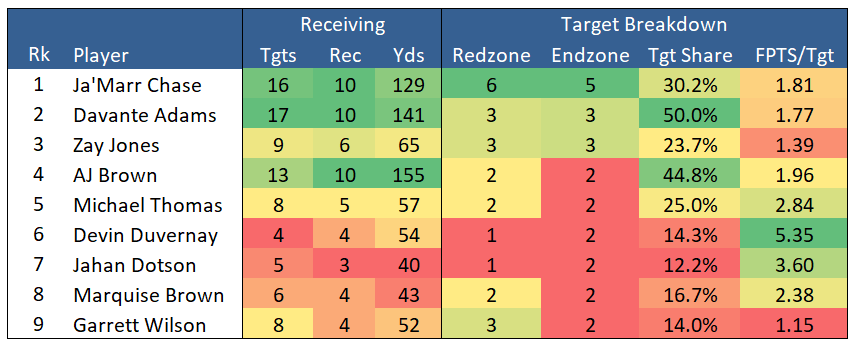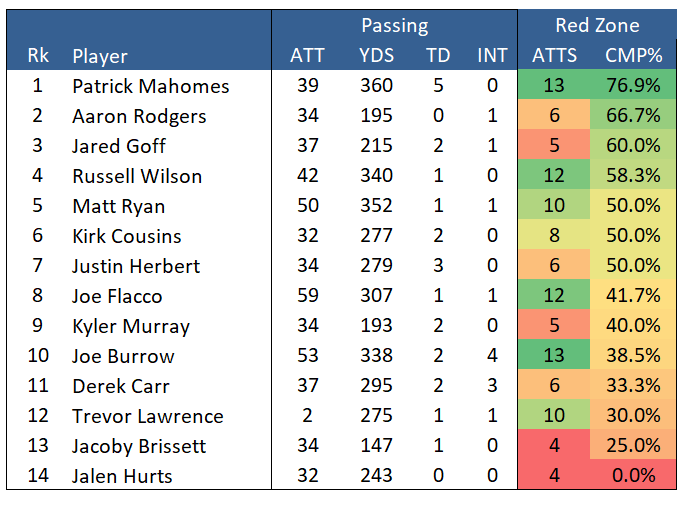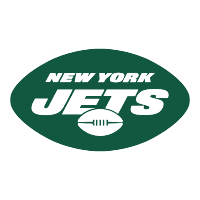Beneath the Surface: Week 1 Recap
Another week of NFL football, another pile of data to sift through looking for clues. Clues as to what lead to certain results and clues for speculating what might be coming next. They say, “looks can be deceiving.” The same can be said for surface-level statistics in fantasy football. In this weekly article series, I will be looking beneath the statistical surface, beyond the standard box score, using the premium statistics provided by FantasyData, including advanced and efficiency metrics across the fantasy skill positions, to search for puzzle pieces that fit together.
The Red Zone
The opponent’s red zone (from the 20-yard line to the endzone) is a valuable area of the field, whether throwing passes, taking hand-offs, or catching passes. For good reason, a player’s opportunity and efficiency in the red zone are highly scrutinized on a week-to-week basis. Who are teams entrusting with those high-value opportunities, and which players are making the most of those opportunities? Touchdowns are known as a “non-sticky” statistic in fantasy football meaning they are more difficult to predict or rely on compared to the other fantasy point-scoring methods (yards and receptions being the other two). But this should not be confused with TDs being completely unpredictable or unreliable.
Among WRs, according to FantasyData’s advanced efficiency metrics, Ja’Marr Chase lead the way in Week 1 with six red zone targets, and five of those targets being in the end zone. It’s bizarre to consider Chase’s PPR WR4 finish as a negative in any way, but he was very close to adding a few more TDs to his day, including barely missing an amazing game-winning TD (his second foot was out by a matter of inches). This bodes well for Chase as he finished with only 12 red zone targets (tied for 34th) last season.
Other than Chase, there were eight other WRs in Week 1 with more than one end zone target:
 Sign Up Today To Continue Reading…
Sign Up Today To Continue Reading…
The rest of this article is for FantasyData Subscribers only. Luckily for you, now is one of the best times of the year to subscribe. We are offering amazing deals on our Annual subscriptions. That means you get all our awesome DFS content, projections, rankings, and tools along with downloadable data for one full year. You will be set up for the rest of this NFL season and almost all of next year!
Patrick Mahomes is an elite QB. I realize this is not a shocking revelation, but concerns did mount during the offseason as to what effect Tyreek Hill being traded to the Miami Dolphins might have on Mahomes’ fantasy output. If Mahomes’ Week 1 performance is any indication, likely none.
Mahomes completed 30 of 39 pass attempts (76.9% completion rate) for 360 yards and five TDs (no picks) against what looks like an exploitable Cardinals defense. Exploitable or not, some of Mahomes’ advanced efficiency statistics were downright ridiculous.
Against Arizona, Mahomes threw 13 passes in the red zone and completed ten of them, for a red zone completion rate of 76.9%, the same as his full game rate oddly enough. Mahomes hasn’t been above 60% in that category over the course of any of his full seasons. Now, the fact that Mahomes threw five TDs already indicates he was pretty good in the red zone on this day. But in an effort to look for the clues that can be used to speculate beyond this one game, the deeper look is important, even for someone like Mahomes. Mahomes’ five TD passes averaged just under four yards per TD, with the longest TD pass being nine yards to Travis Kelce. This indicates that the Chiefs are perfectly fine calling pass plays no matter how close to the goal line they are. Rookie RB Isiah Pacheco did rush one in from the three-yard line, but it wasn’t until garbage time when the Chiefs had the game well in hand. The Chiefs won’t keep up an 83%-17%, passing TD-rushing TD ratio over the course of a season. The Chiefs RB group lacks a true hammer who can reliably punch it in from in close. Pacheco has been a nice preseason story and could develop into an effective goal-line RB. But for now, there may be a lot more short-passing TDs coming.
Mahomes’ 76.9% red zone completion rate was by far the top mark in the NFL among QBs with more than three red zone attempts:
Tempered Expectations
One player I faded during the off-season who I’m preparing to take a loss on is Cordarrelle Patterson. Versus what I consider to be a relatively stingy defense versus the run in the Saints, Patterson took on a workhorse role, turning 25 touches into 136 total yards (5.4 yards/touch) and a TD, including a career-high 22 rush attempts. With rookie Tyler Allgeier a healthy scratch and backup RB Damien Williams suffering a rib injury that kept him on the sideline most of the game, Patterson earned an 84.4% RB opportunity share, fourth highest of Week 1. According to FantasyData’s advance RB metrics, the highest RB opportunity share last season was 86.4% (Najee Harris). But before I fully eat crow, there is additional context that throws a little cold water on the performance.
There are three basic defensive fronts an offense faces on a given play.
- Light: Six or fewer defenders in the box
- Base: Seven defenders in the box
- Stacked: Eight defenders in the box
Generally, the more defenders in the box, the tougher it is to run the ball. FantasyData’s advanced RB metrics include the rates at which RBs face each of these defensive fronts, as well as the average number of defenders in the box. Among RBs with 10+ carries, Patterson faced an average of only 4.8 defenders in the box, a full defender less than the next fewest (Austin Ekeler, 5.8). Patterson saw the following defensive front rates:
- Light: 95.5%
- Base: 4.5%
- Stacked: 0.0%
Call it the “Kyle Pitts Effect,” but Patterson saw zero stacked fronts and only a few base fronts. Now, Patterson still had to capitalize on a defense basically daring the Falcons to run, so I’m not significantly downplaying his performance. But the Falcons came very close to upsetting the Saints largely due to Patterson running all over them, so I doubt teams will average almost 100% light defensive fronts moving forward.
There are two pass catchers who turned in great days when looking only at fantasy points scored: Ravens WR Devin Duvernay and Texans TE O.J. Howard. I started this article talking about red zone statistics and a more logical approach in looking at TDs. It’s the opposite with Duvernay and Howard’s Week 1. Both players scored two TDs, and if you somehow had them in your lineup or stashed on a best ball team, congrats. But I’ve seen some FAAB bids on both this week that are the classic “chasing TDs” scenario.
Duvernay scored 21.4 PPR points on a total of four targets (5.35 per target). Howard scored 17.8 PPR points on a total of two targets (8.90 per target). In fact, Howard ran only six routes, and his 2.97 points per route is a next level outlier.
In 2021, among WRs and TEs, these were the highest PPR. points per target:
- Deebo Samuel (2.82)
- Dawson Know (2.31)
Since 2017, only one WR has averaged more than three PPR points per target (Tyler Lockett at 3.01 in 2017) and no TEs have done it (Tonyan came close in 2020 at 2.99). I realize one-game sample sizes will always have unsustainable outliers like this, but we are limited to the available data and this comparison is to drive home the point not to invest much (if anything) in results like this. Unless either player sees an uptick in opportunity, they should remain on waiver wires in standard size redraft leagues and remain at the end of your bench in dynasty formats.
Players to Monitor
Each week I’ll be providing a few lesser-known players to monitor whose advanced statistics have caught my attention but are still under the radar based on fantasy results.
Ashton Dulin (WR, Indianapolis Colts)
Dulin is a 6’1”, 215-pound WR with 4.43 speed. You may have heard it mentioned that he is a former track star. Undrafted out of Monroe College, Dulin is little known outside of dynasty circles and had only 30 career targets in three seasons prior to 2022. This is a deep call with Dullin having only one career start under his belt. He is not on the radar in redraft and only a potential deep bench stash in dynasty, for now.
The WR pecking order in Indianapolis is wide open beyond their locked in WR1, budding superstar Michael Pittman Jr. Parris Campbell has been added to the concussion protocol and has battled unfortunate injuries throughout his short career with the Colts. I really like rookie WR Alec Pierce as well, but he is raw, and I am more interested in his long-term outlook. Pierce and Dulin both saw two red zone targets in Week 1, but both unfortunately dropped TD passes.
Matt Ryan wasn’t getting much help from receivers not named Michael Pittman on Sunday pic.twitter.com/ZSIwmvB4zx
— Ian Hartitz (@Ihartitz) September 12, 2022
Dulin’s end zone target was promising as he was an early read for Matt Ryan in that goal line play call and to be fair, Dulin’s “drop” was impacted by Texans’ defender Jonathan Owens knocking the ball out as Dulin was getting his two feet in bounds, but he’s got to hang onto that ball.
Dulin is likely the next man up with Campbell iffy for Week 2 and did earn six targets in Week 1 (on only 14 routes), second-most among Colts WRs behind only Pittman Jr. with a healthy Campbell. Dulin also was impressive from two important advanced statistics: Yards per route run (YPRR) and targets per route run (TPRR), leading all Week 1 WRs in the latter category.
Players who saw >3.0 YPRR and >30% TPRR in Week 1:
Justin Jefferson
Treylon Burks
Stefon Diggs
AJ Brown
Austin Ekeler
Davante Adams
Ashton Dulin
Kyle Philips
Antonio Gibson
Mike Evans
Tyreek HillTitans passing game might be undervalued.
— Amr Gabr (@amrgaabr) September 14, 2022
Zay Jones (WR, Jacksonville Jaguars)
Jones is a better-known name than Dulin, having a more prominent start to his NFL career as a second-round draft pick for the Buffalo Bills in 2017. Topping out (so far) in 2018 with 102 targets and seven receiving TDs, Jones’ has had a disappointing career since. However, he may have found new life in his fresh start with the Jaguars, as he was part of their WR overhaul this offseason that also saw Christian Kirk come to Jacksonville and Laviska Shenault traded to the Panthers.
Jones has a solid game in Week 1, catching six of nine targets for 62 yards, accounting for 23.7% of Trevor Lawrence’s targets and 32.1% of the WR targets. Christian Kirk is the Jaguars’ WR1 and that was not in doubt against the Commanders (31.6% target share), but Jones is the WR2 as I think he has the edge on veteran Marvin Jones. And while Jones’ career has been disappointing overall, the Jaguars bringing him in did not come out of nowhere. With the Raiders in 2021, from Week 11 onward, Jones earned an average of 7.7 targets per game.
Jones did not catch a TD pass in Week 1, but it was not for lack of trying. Jones tied Davante Adams with three endzone targets, both trailing only Ja’Marr Chase on the week. And if Week 1 is any indication, the Jaguars’ WR2 will be a valuable fantasy asset this season. The Jaguars WR target share was the fifth-highest of Week 1, while their RB and TE targets shares were both bottom 10.
Where’s it going?
Here is target distribution (to WR, TE, RB) by team after Week 1. One of many things I’ll be updating and providing weekly. pic.twitter.com/QbT1p1rRpr
— Scott Rinear (@MunderDifflinFF) September 14, 2022













































